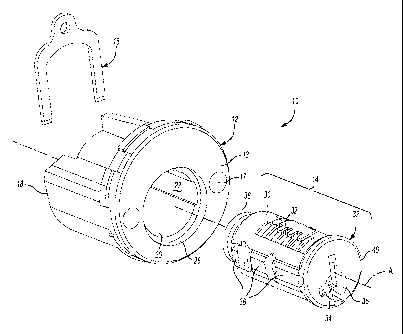Some of the information on this Web page has been provided by external sources. The Government of Canada is not responsible for the accuracy, reliability or currency of the information supplied by external sources. Users wishing to rely upon this information should consult directly with the source of the information. Content provided by external sources is not subject to official languages, privacy and accessibility requirements.
Any discrepancies in the text and image of the Claims and Abstract are due to differing posting times. Text of the Claims and Abstract are posted:
| (12) Patent: | (11) CA 2557331 |
|---|---|
| (54) English Title: | FRONT LOADING LOCK ASSEMBLY |
| (54) French Title: | ENSEMBLE VERROU A CHARGEMENT FRONTAL |
| Status: | Granted and Issued |
| (51) International Patent Classification (IPC): |
|
|---|---|
| (72) Inventors : |
|
| (73) Owners : |
|
| (71) Applicants : |
|
| (74) Agent: | SMART & BIGGAR LP |
| (74) Associate agent: | |
| (45) Issued: | 2012-12-04 |
| (86) PCT Filing Date: | 2005-03-01 |
| (87) Open to Public Inspection: | 2005-09-15 |
| Examination requested: | 2010-02-25 |
| Availability of licence: | N/A |
| Dedicated to the Public: | N/A |
| (25) Language of filing: | English |
| Patent Cooperation Treaty (PCT): | Yes |
|---|---|
| (86) PCT Filing Number: | PCT/US2005/006449 |
| (87) International Publication Number: | WO 2005085566 |
| (85) National Entry: | 2006-08-24 |
| (30) Application Priority Data: | ||||||
|---|---|---|---|---|---|---|
|
A lock assembly includes a housing, a core assembly and a retainer. The
housing includes a housing retainer groove located generally transverse to an
axis defined by a bore through the housing, which corresponds with a core
retainer groove. When the core assembly is mounted within the bore, the
retainer groves are aligned. The retainer is inserted into the grooves such
that a bridge portion of the retainer is engaged by an engagement feature to
secure the retainer and thereby mount the core assembly into the housing.
L'invention concerne un ensemble verrou comportant un boîtier, un ensemble central et un dispositif de retenue. Le boîtier comporte une rainure de retenue de boîtier située d'ordinaire transversalement par rapport à un axe défini par un trou traversant le boîtier, qui correspond à une rainure de retenue centrale. Lorsque l'ensemble central est placé à l'intérieur du trou, les rainures de retenue sont alignées. Le dispositif de retenue est introduit dans les rainures de façon qu'une partie pont du dispositif de retenue vienne en prise avec une caractéristique de contact pour fixer le dispositif de retenue et placer l'ensemble central à l'intérieur du boîtier.
Note: Claims are shown in the official language in which they were submitted.
Note: Descriptions are shown in the official language in which they were submitted.

2024-08-01:As part of the Next Generation Patents (NGP) transition, the Canadian Patents Database (CPD) now contains a more detailed Event History, which replicates the Event Log of our new back-office solution.
Please note that "Inactive:" events refers to events no longer in use in our new back-office solution.
For a clearer understanding of the status of the application/patent presented on this page, the site Disclaimer , as well as the definitions for Patent , Event History , Maintenance Fee and Payment History should be consulted.
| Description | Date |
|---|---|
| Inactive: Recording certificate (Transfer) | 2024-01-08 |
| Inactive: Multiple transfers | 2023-11-30 |
| Change of Address or Method of Correspondence Request Received | 2019-11-20 |
| Common Representative Appointed | 2019-10-30 |
| Common Representative Appointed | 2019-10-30 |
| Letter Sent | 2013-03-20 |
| Revocation of Agent Requirements Determined Compliant | 2013-02-01 |
| Inactive: Office letter | 2013-02-01 |
| Inactive: Office letter | 2013-02-01 |
| Appointment of Agent Requirements Determined Compliant | 2013-02-01 |
| Revocation of Agent Request | 2013-01-21 |
| Appointment of Agent Request | 2013-01-21 |
| Appointment of Agent Requirements Determined Compliant | 2013-01-16 |
| Revocation of Agent Requirements Determined Compliant | 2013-01-16 |
| Inactive: Office letter | 2013-01-14 |
| Appointment of Agent Request | 2012-12-19 |
| Revocation of Agent Request | 2012-12-19 |
| Grant by Issuance | 2012-12-04 |
| Inactive: Cover page published | 2012-12-03 |
| Pre-grant | 2012-09-25 |
| Inactive: Final fee received | 2012-09-25 |
| Letter Sent | 2012-04-03 |
| Notice of Allowance is Issued | 2012-04-03 |
| Notice of Allowance is Issued | 2012-04-03 |
| Inactive: Approved for allowance (AFA) | 2012-03-23 |
| Amendment Received - Voluntary Amendment | 2011-10-19 |
| Inactive: S.30(2) Rules - Examiner requisition | 2011-09-02 |
| Amendment Received - Voluntary Amendment | 2010-04-27 |
| Letter Sent | 2010-03-12 |
| Request for Examination Received | 2010-02-25 |
| Request for Examination Requirements Determined Compliant | 2010-02-25 |
| All Requirements for Examination Determined Compliant | 2010-02-25 |
| Inactive: Cover page published | 2006-10-23 |
| Inactive: Notice - National entry - No RFE | 2006-10-18 |
| Letter Sent | 2006-10-18 |
| Application Received - PCT | 2006-09-25 |
| National Entry Requirements Determined Compliant | 2006-08-24 |
| Application Published (Open to Public Inspection) | 2005-09-15 |
There is no abandonment history.
The last payment was received on 2012-02-27
Note : If the full payment has not been received on or before the date indicated, a further fee may be required which may be one of the following
Please refer to the CIPO Patent Fees web page to see all current fee amounts.
Note: Records showing the ownership history in alphabetical order.
| Current Owners on Record |
|---|
| ASSA ABLOY AMERICAS RESIDENTIAL INC. |
| Past Owners on Record |
|---|
| FRANKLIN T. NAKASONE |